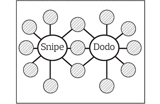Set pupils a challenge that's closer to home and they will be itching to make a difference, says Steve Bunce...
Can we cure the cold? Can we survive without oil? How can we stop the Arctic melting? These are all big questions; but can we do anything about them? More importantly, can our children come up with the solutions? Using an approach called Challenge Based Learning, perhaps they can.
At its heart, Challenge Based Learning is a collaborative learning experience in which teachers and pupils work together to learn about compelling issues, propose solutions to real problems, and take action. The approach asks children to reflect on their learning and the impact of their actions and publish their solutions to a worldwide audience.
It’s a process that enables children to tackle big questions by breaking them down into smaller challenges. It also provides a structure for combining classroom enquiry with ICT – an introduction to which you can find on the Apple Education website (ali.apple.com/cbl).
 A Challenge Based Learning project begins with a ‘big idea’. This could be linked to the sustainability of natural resources such as water, food, energy and air; or it might involve thinking about our health, our economy, world conflicts, or climate change.
A Challenge Based Learning project begins with a ‘big idea’. This could be linked to the sustainability of natural resources such as water, food, energy and air; or it might involve thinking about our health, our economy, world conflicts, or climate change.
The big ideas need to be broken into smaller parts by creating ‘essential questions’. For example, essential questions about sustainability might be: ‘What is the impact of my water consumption on my community?; for health, ‘Can I stop colds and flu being spread?; and for climate change, ‘What is the impact of my use of fossil fuels on the planet?’
The next step is the challenge. This turns the essential question into a call for action – something that pupils can act on immediately. It should have a global significance but yet be close enough to home so that it has a personal significance for pupils. Challenges also need to be difficult and should have multiple solutions. Good examples include:
• Reduce your family’s water consumption
• Reduce the use of fossil fuels by getting your friends walking to school
• Increase awareness of how colds are spread
A school in the North East of England was keen to try out Challenge Based Learning with its Y5 pupils. The class started with the big question, ‘Will we ever become extinct?’ which they discussed before putting forward their opinions:
• ‘We won’t become extinct because everyone has mummies and daddies’
• ‘Not everyone’
• ‘I’ve got a baby brother, so people could always have more children if they wanted’
• ‘In China, they are only allowed one baby because there were too many people there’
 This discussion led to the essential question, ‘What do we mean by extinct?’ The children already knew the word ‘extinct’ refers to a species that has no living member, but they couldn’t think of any examples. The prompt from the teacher was, “Do you know the phrase ‘as dead as a dodo’?” One of children responded that his grandparents used it sometimes.
This discussion led to the essential question, ‘What do we mean by extinct?’ The children already knew the word ‘extinct’ refers to a species that has no living member, but they couldn’t think of any examples. The prompt from the teacher was, “Do you know the phrase ‘as dead as a dodo’?” One of children responded that his grandparents used it sometimes.
 The next step was to show a video clip from the Disney Pixar’s film Up. In the film, an explorer has dedicated his life to discovering the ‘snipe’ - a colourful bird not too disimilar to the dodo – that’s thought to be extinct (you can see the Snipe here, youtube.com/watchv=7KiLhWihYVM). Having watched the film clip, the children then analysed the features of the Snipe using a simple framework.
The next step was to show a video clip from the Disney Pixar’s film Up. In the film, an explorer has dedicated his life to discovering the ‘snipe’ - a colourful bird not too disimilar to the dodo – that’s thought to be extinct (you can see the Snipe here, youtube.com/watchv=7KiLhWihYVM). Having watched the film clip, the children then analysed the features of the Snipe using a simple framework.
A picture of a Dodo was then introduced and the children compared the characteristics of the two birds, looking at what was different and what they had in common.
From here, a challenge needed to be set that would make the issue of extinction personal to pupils.
The children lived in an area just outside of Newcastle where red squirrels can still be found – although they are currently under threat by grey squirrels. This local issue became the subject of the challenge, ‘How can we stop the red squirrels becoming extinct?’.
To start things off, teacher questions helped the pupils clarify their thinking: ‘Why are the red squirrels bullied by the greys?’, ‘Do they compete for the same food?’, ‘How are the red squirrels being affected?’
The children then returned to the comparison framework they had drawn up for the Dodo and the Snipe and used the same process to compare the characteristics of the red and grey squirrels.
As part of their research, pupils used three apps on an iPad that focused on endangered creatures. This helped the children to not only learn about species at risk of extinction, but also to find out that humans were often the greatest threat.
The children were initially directed to selected websites to find out about the squirrels. This enabled them to find relevant information quickly. They were then able to search for their own websites to gather further ideas. It became apparent that a ‘squirrel pox’ is killing the red squirrels but not the grey squirrels, as they are immune - a revelation to the children.
The children worked in groups to find solutions and they presented these to the class. They decided to create wanted posters, ‘Have you seen this grey squirrel?’ and planned to tell their families and friends about the issue. Other groups decided to help spotting red squirrels and found a website of a local group already adding sightings to a map.
Reflecting on the experience was essential. The pupils thought about the whole process, going from a big idea to a challenge and then action. When asked again, ‘Will we become extinct?’ they answered that it could happen. Possible causes suggested by the children included, ‘What if a disease like squirrel pox wipes us out?’ and ‘What if aliens come, who are bigger than us?’
The children thoroughly enjoyed the whole process and are keen to be challenged again. Are you?
 Publishing the children’s work is an essential part of the Challenge Based Learning process. They need to think carefully how to convey their message to the audience they are trying to convince. It also gives a feeling of accomplishment. For the extinction challenge, children could:
Publishing the children’s work is an essential part of the Challenge Based Learning process. They need to think carefully how to convey their message to the audience they are trying to convince. It also gives a feeling of accomplishment. For the extinction challenge, children could:
1. Be a TV presenter reporting live from the woods – how can we save the red squirrels? Send the video to the local TV news.
2 Create a poster of a grey squirrel with the reasons why it is wanted. Post it up around your school.
3. Using a class blog, describe a day in the life of a red squirrel. Ask parents to add comments to the posts.
4. Create pages on your school website to include sightings of the red squirrels and add markers to an online map.
Steve Bunce is VITAL’s ICT CPD leader for the North East and Yorkshire & Humber at Open University. VITAL is all about supporting teachers and schools to develop their use of ICT professionally (vital.ac.uk).
Supporting parents with maths
Ace-Maths
Make World Book Day Extra Special This Year
Ace-English
5 friendship and emotions intervention ideas
Ace-Classroom-Support
